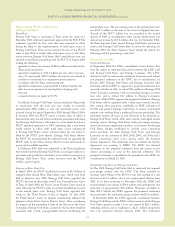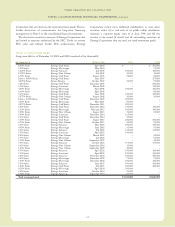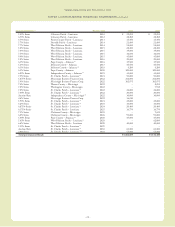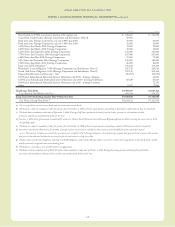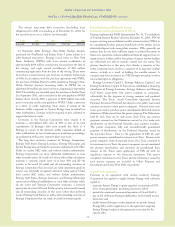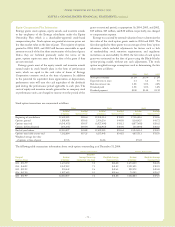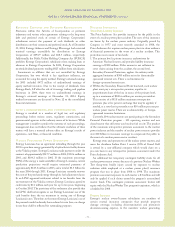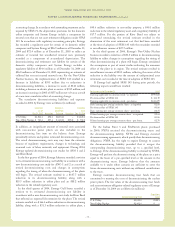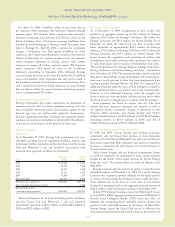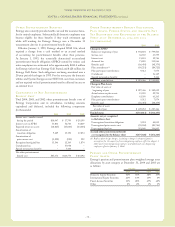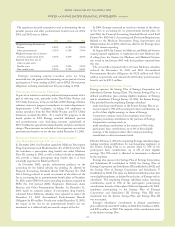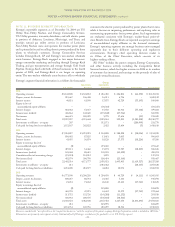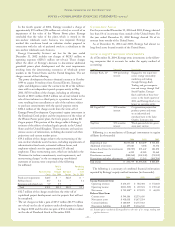Entergy 2004 Annual Report Download - page 75
Download and view the complete annual report
Please find page 75 of the 2004 Entergy annual report below. You can navigate through the pages in the report by either clicking on the pages listed below, or by using the keyword search tool below to find specific information within the annual report.
Entergy Corporation and Subsidiaries 2004
-73 -
Retained Earnings and Dividend Restrictions
Provisions within the Articles of Incorporation or pertinent
indentures and various other agreements relating to the long-term
debt and preferred stock of certain of Entergy Corporation’s
subsidiaries restrict the payment of cash dividends or other
distributions on their common and preferred stock. As of December
31, 2004, Entergy Arkansas and Entergy Mississippi had restricted
retained earnings unavailable for distribution to Entergy
Corporation of $394.9 million and $68.5 million, respectively.
Additionally, the Public Utility Holding Company Act (PUHCA)
prohibits Entergy Corporation’s subsidiaries from making loans or
advances to Entergy Corporation. In 2004, Entergy Corporation
received dividend payments totaling $825 million from subsidiaries.
Investments in affiliates that are not controlled by Entergy
Corporation, but over which it has significant influence, are
accounted for using the equity method. Entergy’s retained earnings
for 2003 included $472 million of undistributed earnings of
equitymethod investees. Due to the receipt of dividends from
Entergy-Koch, LP after the sale of its energy trading and pipeline
businesses in 2004, therewereno undistributed earnings in
Entergy’s retained earnings at December 31, 2004. Equity
method investments are discussed in Note 12 to the consolidated
financial statements.
NOTE 8. COMMITMENTS AND CONTINGENCIES
Entergyis involved in a number of legal, tax, and regulatory
proceedings before various courts, regulatory commissions, and
governmental agencies in the ordinarycourse of its business. While
management is unable to predict the outcome of suchproceedings,
management does not believe that the ultimate resolution of these
matters willhave a material adverse effect onEntergy’s results of
operations, cash flows, or financial condition.
Vidalia Purchased Power Agreement
Entergy Louisiana has an agreement extending through the year
2031 to purchase energy generated by a hydroelectric facility known
as the Vidalia project. Entergy Louisiana made payments under the
contract of approximately $147.7 million in 2004, $112.6 million in
2003, and $104.2 million in 2002. If the maximum percentage
(94%) of the energy is made available to Entergy Louisiana, current
production projections would require estimated payments of
approximately $125.3 million in 2005, and a total of $3.5 billion for
the years 2006 through 2031. Entergy Louisiana currently recovers
the costs of the purchased energy through its fuel adjustment clause.
In an LPSC-approved settlement related to tax benefits from the
tax treatment of the Vidalia contract, Entergy Louisiana agreed to
credit rates by $11 million each year for up to ten years, beginning
in October 2002. The provisions of the settlement also provide that
the LPSC shall not recognize or use Entergy Louisiana’s use of the
cash benefits from the tax treatment in setting any of Entergy
Louisiana’s rates.Therefore, to the extent Entergy Louisiana’s use of
the proceeds would ordinarily have reduced its rate base, no change
in rate base shall be reflected for ratemaking purposes.
Nuclear Insurance
Third Party Liability Insurance
The Price-Anderson Act provides insurance for the public in the
event of a nuclear power plant accident. The costs of this insurance
are borne by the nuclear power industry. Originally passed by
Congress in 1957 and most recently amended in 1988, the
Price-Anderson Act requires nuclear power plants to show evidence
of financial protection in the event of a nuclear accident. This
protection must consist of two levels:
1. The primary level is private insurance underwritten by
American Nuclear Insurers and provides liability insurance
coverage of $300 million. If this amount is not sufficient to
cover claims arising from the accident, the second level,
Secondary Financial Protection, applies. An industry-wide
aggregate limitation of $300 million exists for domestically-
sponsored terrorist acts. There is no limitation for
foreign-sponsored terrorist acts.
2. Within the Secondary Financial Protection level, each nuclear
plant must pay a retrospective premium, equal to its
proportionate shareof the loss in excess of the primary level,
up to a maximum of $100.6 million per reactor per incident.
This consists of a $95.8 million maximum retrospective
premium plus a fivepercent surcharge that may be applied, if
needed, at a rate that is presently set at $10 million per year per
nuclear power reactor. There are no domestically- or foreign-
sponsored terrorism limitations.
Currently, 104 nuclear reactors are participating in the Secondary
Financial Protection program - 103 operating reactors and one
closed reactor that stillstores used nuclear fuel on site. The product
of the maximum retrospective premium assessment to the nuclear
power industryand the number of nuclear power reactors provides
over $10 billion in insurance coverage to compensate the public in
the event of a nuclear power reactor accident.
Entergy owns and operates ten of the nuclear power reactors, and
owns the shutdown Indian Point 1 reactor (10% of Grand Gulf
is owned by a non-affiliated company which would share on a
pro-rata basis in any retrospective premium assessment under the
Price-Anderson Act).
An additional but temporary contingent liability exists for all
nuclear power reactor owners because of a previous Nuclear Worker
Tort(long-termbodilyinjury caused by exposureto nuclear
radiation while employed at a nuclear power plant) insurance
program that was in place from1988 to 1998. The maximum
premium assessment exposure to each reactor is $3 millionand will
only be applied if such claims exceed the program’s accumulated
reservefunds. This contingent premium assessment feature will
expirewith the Nuclear Worker Tort program’s expiration, which is
scheduled for 2008.
Property Insurance
Entergy’snuclear owner/licensee subsidiaries are members of
certain mutual insurance companies that provide property
damage coverage, including decontamination and premature
decommissioning expense, to the members’ nuclear generating
NOTES to CONSOLIDATED FINANCIAL STATEMENTS continued


